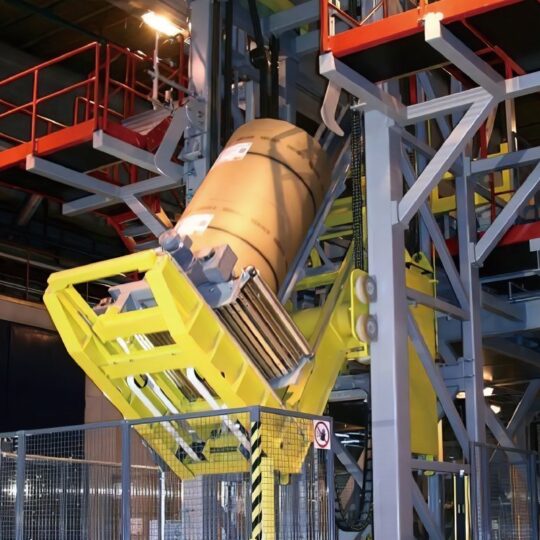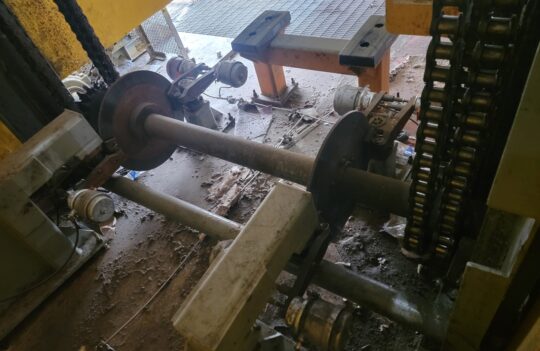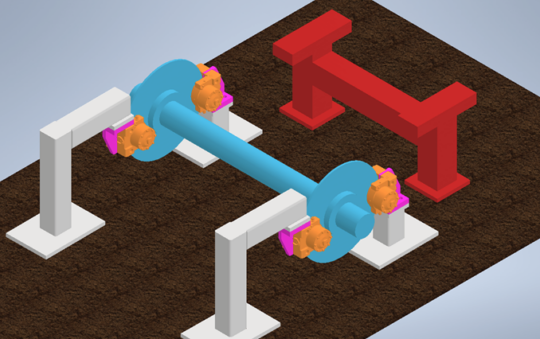Background:
A specialized engineering firm focused on serving the pulp and paper industry was engaged by one of the largest privately owned paper, packaging, and distribution companies in the world for engineering and design assistance with their paper roll lowerator upender.
The end user’s lowerator upender receives a paper roll of ~14,000 lb. in the horizontal position, lowers the roll on a sled, rotates the roll 90 degrees, and places the roll onto another conveyor in a vertical position.

A lowerator upender, a key piece of material handling equipment at a paper factory, in action.
The original emergency braking system installed on the lowerator upender drivetrain was at risk failing, creating safety and process reliability concerns for the end user. The end user wanted to upgrade this emergency braking system to ensure safety during operation of the lowerator upender if the drive system experienced a catastrophic failure or malfunction with the motor brake or gearbox.

The existing pneumatic caliper disc brake system used for emergency braking on the paper roll upender.
Due in part to Hindon’s experience with designing and supplying retrofit emergency braking systems across industries, the engineering firm partnered with Hindon to support the end user in determining the best industrial braking system for this application.
Application Challenges:
- Limited technical information available due to age of existing equipment
- Retrofit application with space and mounting constraints
- High torque requirement necessitated use of different brake type
Solution:
Working collaboratively (and at times creatively) with the customer, Hindon helped the parties fully understand the design and specifications of the original equipment, which helped inform the root cause of the failure modes experienced by the customer with respect to the industrial emergency brakes.
Hindon determined that the ideal replacement brakes would not only need to remain on the gearbox output shaft to serve as true emergency brakes but would ideally reuse the existing brake discs and mounting stands due to the dimensional constraints in the application. After applying an appropriate safety factor for the application to the calculated full load torque, Hindon helped determine that the existing pneumatic brakes were undersized for the application.
Because the existing brakes were pneumatically released, Hindon explored several spring applied pneumatically released designs. However, after thorough evaluation and in combination with other project constraints, Hindon determined that the appropriate braking torque could not be achieved with pneumatic brakes.
Instead, Hindon designed and supplied a hydraulic emergency braking system consisting of four spring applied hydraulically released caliper disc brakes for use on the customer’s two existing 35” diameter discs along with a compact hydraulic power unit (HPU) for brake control and custom mounting stands for use with the existing brake mounts.

Hindon’s 3D model of the application shows the hydraulic caliper braking system (orange) attached to the existing brake discs (blue) along with custom mounts (magenta) attached to the existing mounts (gray).
This retrofit emergency braking system was ideal for this application for several key reasons.
First, the use of high torque capacity hydraulic brakes allowed Hindon to design a system with the appropriate torque capacity while staying within the dimensional envelope of the existing braking system. The hydraulically released system also has a faster reaction time resulting in less pad wear and ongoing maintenance needs over time (e.g., brake adjustment).
With the torque requirement satisfied, Hindon’s ability to create custom mounting stand adapters to reuse the existing caliper mounts was critical to providing the most cost-effective solution that fit within the established dimensional constraints.
Lastly, as the new emergency braking system was capable of increased torque capacity, it was critical to understand if the lowerator upender drivetrain and existing brake mounts could withstand these higher braking torques. To technically analyze this question, Hindon performed Finite Element Analysis (FEA) whereby the existing system was modeled and subjected to the new higher torque levels. This FEA helped inform the design of the brake mounting stands and ensured the new emergency braking system was suitable for use with the existing lowerator upender.
This project highlights the potential complexity associated with designing and supplying a retrofit emergency braking system in a situation with limited information, several potential failure modes, and significant existing project constraints. Working in partnership with the customer in support of the end user, Hindon’s product knowledge, application experience, technical know-how, and willingness to thoroughly assess the situation from all angles resulted in a robust, reliable, and cost-effective industrial braking solution for this lowerator upender emergency braking system retrofit.